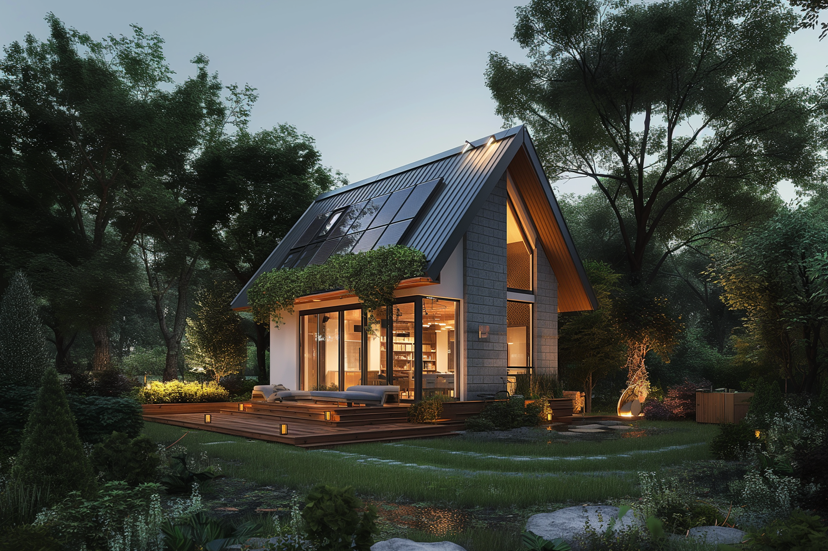
Green energy homes have gained significant popularity due to their sustainable features and positive impact on the environment. Green homes provide 4 key benefits that go beyond mere construction and efficiency.
What are green energy homes?
Green energy homes are properties that are designed and constructed to provide a safe, healthy, and sustainable living environment. These homes provide cleaner indoor air, leading to improved respiratory health for occupants. Additionally, they are designed to save significantly on energy and water usage, contributing to both cost savings and environmental conservation efforts.
What are Green Certified Homes?
Green energy certified properties prioritize the use of materials that promote health and enhance resilience against various environmental factors. LEED (Leadership in Energy and Environmental Design) certified homes achieve at least a 15% reduction in energy consumption compared to homes built to standard code. They also excel in water conservation, with savings of up to 20% compared to traditional homes.
To earn LEED certification, projects undergo a rigorous third-party verification process, including onsite inspections and performance testing. This certification serves as a testament to a home’s adherence to green building principles and its commitment to saving energy, water, and other valuable resources. Currently, more than 1.6 million residential units worldwide participate in LEED, highlighting the growing demand and recognition for sustainable and environmentally conscious homes.
Below are 4 benefits of green energy homes:
Saves Money:
According to the U.S. Energy Information Administration, the average monthly electric bill in the U.S. is $117 with heating and cooling accounting for about 32% of electricity consumption. Green homes use less energy and help families lower utility bills. On average, LEED certified homes use 20-30% less energy and water, with some reporting up to 60% in energy savings.
Healthier Indoor Environments:
According to the EPA, concentrations of some pollutants are two to five times higher indoors than outdoors. Green homes maximize indoor fresh air and prioritize strategies and materials that minimize exposure to airborne toxins and pollutants that can negatively impact human health.
Delivering Value:
With proper planning, green homes can be built for the same or close to the same cost as non-green homes, with residents continuing to saving money thanks to energy and water reductions. Green homes can also qualify for discounted homeowners’ insurance, tax breaks and other incentives. In many markets, certified green homes sell quicker and for more money than comparable non-green homes.
Increases Home Value:
Green energy homes are known for maintaining their value over time. Their sustainable features and efficient design ensure long-term durability and desirability in the real estate market. According to research conducted by Freddie Mac, on average, green rated homes are sold for 2.7% more than unrated homes. Those with better ratings sold for 3-5% more than lesser-rated homes. In a recent edition of “What Home Buyers Really Want,” the NAHB found that surveyed homebuyers are looking for energy efficiency. With utility costs increasing around the country, this probably doesn’t come as a big surprise, but the statistics show just how in-demand green features are. Consider the following:
-
-
- 83% of buyers want ENERGY STAR®-rated windows.
- 81% of buyers want ENERGY STAR®-rated appliances.
- 80% of buyers want energy-efficient lighting.
- 79% of buyers want an ENERGY STAR® rating for the entire home.
- 73% of buyers want triple-pane insulated glass windows.
-
Examples of green energy systems:
There is a diverse range of green energy systems available, each offering unique benefits and capabilities. Each of these green energy systems plays a crucial role in reducing carbon emissions and promoting sustainable energy practices.
-
- Solar panels
- Wind turbines
- Geothermal heat pumps
- Solar water heaters
- Energy efficient windows
- Cool roofs
- High-performance insulation
- Smart thermostats
Embracing green energy is a great step towards a sustainable future. By harnessing renewable sources like solar, wind, and geothermal, we can reduce our carbon footprint, mitigate climate change impacts, and create a cleaner, healthier environment for generations to come.
Additionally, integrating green energy solutions into homes can significantly increase their value, making them more attractive to buyers and enhancing long-term property investments. It’s time to prioritize and invest in these technologies to build a greener, more resilient world for all.
Did you know?
There are green energy mortgages available as well as tax incentives?
Connect with one of our recommended lenders today!
RESOURCES:
-
- Leadership in Energy and Environmental Design (LEED), which is awarded by the U.S. Green Building Council (USGBC)
- ENERGY STAR®, which is awarded by the EPA and the Department of Energy (DOE)
- National Green Building Standard, which is awarded by Home Innovation Research Labs, an independent subsidiary of the National Association of Home Builders (NAHB)
- Seasonal Energy Efficiency Rating (SEER)
- The Residential Energy Services Network (RESNET) is responsible for developing the Home Energy Rating System (HERS), which uses an index to determine a home’s energy efficiency.
- The Department of Energy (DOE) evaluates existing homes based on the Home Energy Score (HES) program.